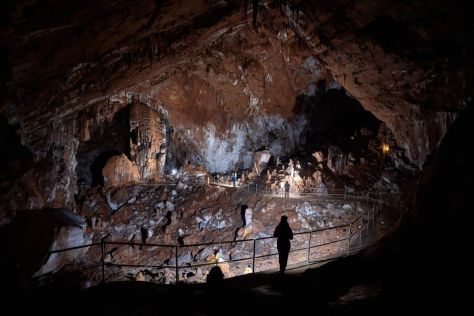
"... we may well say that the underground of Paklenica is just as beautiful, or even more beautiful than its forest and steep cliffs above the ground." (Josip Poljak, 1929)
Paklenica National Park is abundant with many karstic phenomena among which the most significant ones are those under the ground, such as caves and pits. The first written data on the exploration of speleological objects in the Park area date back to the 19th century and are connected to the collection and research of cave insects. Until the Second World War, a smaller number of caves had been explored in the Park area, after the War and after the proclamation of Paklenica as a national park, the explorations have been continuously carried out, with weaker or greater intensity.
The explored speleological objects confirm the great value of this National Park since these are significant palaeontological, archaeological, ethnographic, biospeleological and tourist localities.
Very valuable palaeontological sites are the Cave in Zub Buljme and the Pit in Zub Buljme, where a 30 000-year old cave bear’s (Ursus spelaeus) skull was found.
The local residents have been familiar with some speleological objects in the area of Paklenica National Park for a very long time. The fragments of ceramics and bones were found in the Cave in Pazjanice which indicates a temporary stay of people back in the Copper Age and Bronze Age (3 000 – 1 000 BC).
People had been using caves as shelters for a couple of decades, and we can find evidence of their activity in the form of supporting masonry and outbuildings at the entrances of a dozen caves. These are mostly small facilities that were used in the past by the local inhabitants as shelters for cattle and other goods. The caves that particularly stand out are Babunjuša, Kneževića Cave, Mokrača, Krumpirova Cave, Marasovića Cave and Lukčeva Cave (Škiljića stan).
So far, 120 speleological objects have been explored in the Park area, pits and caves.
The deepest pit is the Ponor on Bunovac, it is 534 meters deep and is still one of the deepest pits in Croatia.
The Cavern in Crljeni kuk also stands out with its 152 - meter depth and is also significant because of the dimensions of the hall which is over 100 meters in diameter, making it one of the largest underground cavities in our karstic area.
Particularly attractive is the 103 - meter deep Pit of Beautiful Fossils, because of its large accumulation of fossil remains of Lithiotis bivalves.
The longest cave is Vodarica Pit which is 300 meters long, while the Cave in Zub Buljme is 250 meters long. Lucinka Cave is 132 meters long and its 51-meter-long entrance is one of the biggest cave entrances in our karstic area. Its interior dimensions are also exceptional.
The caves with preserved ice represent a specific form of speleological objects – they are the caves or pits where ice or snow stay almost the entire year or all year round and they are located on the peaks of the Park. Particular caves with preserved ice are used as a source of drinking water during the summer grazing season.
Visiting speleological objects and collecting biological and geological materials without a permit is strictly forbidden!
The deepest speleological objects in Paklenica
• Precipice on Bunovac (534 m)
• Cavern in Crljeni kuk (152 m)
• Pit in Zub Buljme (139 m)
• Pit under Počiteljski vrh (123 m)
• Pit of Beautiful Fossils (103 m)
The longest caves in the Park
• Vodarica Pit (300 m)
• Cave in Zub Buljme (250 m)
• Manita peć (175 m)
• Lucinka Cave (132 m)





















